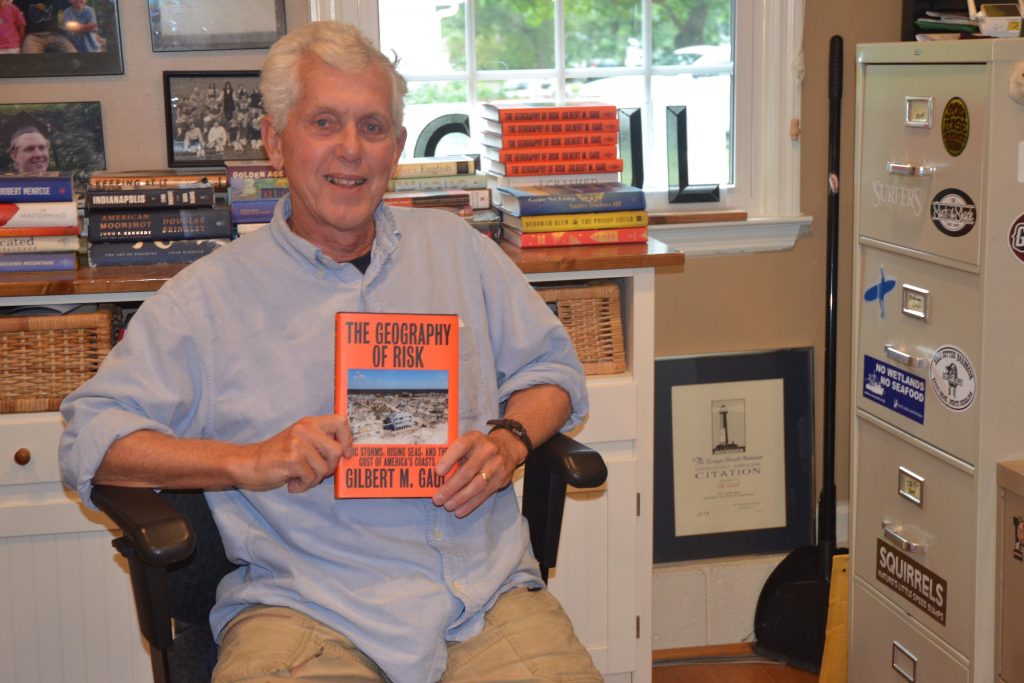

Gilbert Gaul had no background in journalism. In the mid-1970s, he and his wife had just moved to Pennsylvania when he wandered into a tiny, local newspaper office. One of its reporters had just walked out six hours earlier, and without any training, Gaul suddenly found himself reporting the news.
And you could say it’s gone pretty well ever since. The Cherry Hill resident was awarded the Pulitzer Prize in 1979 and again in 1990, and he’s been shortlisted for the prize four other times. He’s made a career of storytelling publishing four books to date. His latest, “The Geography of Risk: Epic Storms, Rising Seas, and The Cost of America’s Coasts,” delves into the economic impact of changing weather patterns.
Gaul said every story has come to him a bit differently. Some of them were a matter of being in the right place at the right time. Others were born of out of curiousity and a lot of them were “just dumb luck.” “The Geography of Risk” was the byproduct of his affinity for the coastline and Mother Nature.
A self-described “beach guy,” Gaul was working on his book “Billion Dollar Ball: A Journey Through the Big Money Culture of College Football” when Hurricane Sandy hit in 2012.
“I was looking at that, and I thought, ‘There’s a book to be done in the coasts and storms and climate change and hurricane damage,’” Gaul said.
He began ruminating on what happens after a hurricane strikes. He said the initial focus and stories are typically on the damage, the losses and the human impact (all of which he says are appropriate) but rarely does anyone step back after and ask the larger questions.
“Why are we building in one of the riskiest places on the planet, and why have we gotten to the point where there’s trillions of dollars in property along barrier island, back bays, coasts?” Gaul asked.
So, he set out to do a little research and quickly found there was no shortage of data on the subject. In the last two decades alone, the United States incurred $750 billion in hurricane damage. In all of recorded history, there’s been about $1.2 trillion worth of damage, so Gaul set out to discover why the costliest hurricanes have all occurred in the last two decades.
“The Geography of Risk” takes a look at the modern-day history of the coastline back to roughly the 1950s. Gaul said, after World War II, the economy was booming, money was flowing into the nation, and after years of sacrifice and strife, people were eager to spend money on themselves. The convergence of these factors created a market for second homes at the beach, and an “extraordinary push” for developing the coast followed.
Gaul said none of this development was planned. Over the next three to four decades, thousands and thousands of homes were built, and no one stopped to ask if was a good idea. Today, the United States has around $3 trillion worth of property on the Atlantic Gulf Coast, and almost all of these are second homes, investment properties and rental properties.
He said much of this infrastructure has been subsidized – both directly and indirectly – by the federal government through flood insurance, widening of beaches, building new bridges, utilities and roads, and in doing so, it has encouraged what Gaul’s calling “wreckless development of the coast.”
So, what happens now that all of this property is sitting in harm’s way? Extraordinary events result in extraordinary damage, and the United States finds itself in a loop of a storm strike followed by rebuilding in harm’s way, according to Gaul. He said with climate change leading to warming oceans and rising sea levels, more powerful storms are inevitably coming down the pipeline and amplifying the risks at the coasts.
“There’s millions of homes sitting there at the edge of the ocean in the Gulf of Mexico, and they’re just waiting to get hit; it’s a shooting gallery for storms,” Gaul said.
He said his hope is that the book helps to jumpstart a national conversation about the coast, what the risks are, who pays for those risks and how Americans are bearing the cost. While there are some steps that can be taken – and varying degrees of optimism that the United States can engineer its way out of these issues – for his part, Gaul is hoping these conversations lead to a fix, so that there are beaches left one day for his grandkids.
“The Geography of Risk: Epic Storms, Rising Seas, and the Cost of America’s Coasts” is currently available on Amazon and at Barnes & Noble. Gaul will speak at the Cherry Hill Public Library on Tuesday, Oct. 22 at 7 p.m. Visit https://chplnj.org/ to register.









